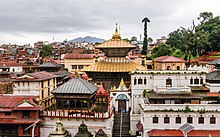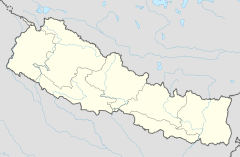
Back معبد باشوباتيناث ARZ পশুপতিনাথ মন্দিৰ Assamese Kuil Pashupatinath BAN पशुपतिनाथ मंदिर Bihari পশুপতিনাথ মন্দির Bengali/Bangla Pašupatináth Czech Pashupatinath German पशुपतिनाथ मन्दिर DTY Ναός Πασουπατινάθ Greek Templo Pashupatinath Spanish
| Pashupatinath Temple | |
|---|---|
श्री पशुपतिनाथ मन्दिर | |
 Pashupatinath Temple, associated with Shiva as 'the lord of all beings' | |
| Religion | |
| Affiliation | Hinduism |
| District | Kathmandu |
| Province | Bagmati Province |
| Deity | Shiva (as Pashupati) |
| Festivals | Maha Shivaratri, Teej |
| Features |
|
| Location | |
| Location | Kathmandu |
| Country | Nepal |
Location in Nepal | |
| Geographic coordinates | 27°42′35″N 85°20′55″E / 27.70972°N 85.34861°E |
| Architecture | |
| Type | Pagoda |
| Date established | 5th century CE |
| Specifications | |
| Site area | 2,460,000 m² |
| Temple(s) | 519 Pagodas |
| Elevation | 817 m (2,680 ft) |
| Criteria | Cultural: (iii)(iv)(vi) |
| Designated | 1979 (3rd session) |
| Part of | Kathmandu Valley |
| Reference no. | 121bis-006 |
The Pashupatinath Temple (Nepali: पशुपतिनाथ मन्दिर) is a Hindu temple dedicated to Pashupati, a form of Shiva. It is located in Kathmandu, Nepal, on the bank of the Bagmati River. The temple was classified as a World Heritage Site in 1979. This "extensive Hindu temple precinct" is a "sprawling collection of temples, ashrams, images and inscriptions raised over the centuries along the banks of the sacred Bagmati river", and is one of seven monument groups in UNESCO's designation of Kathmandu Valley.[1] The temple, considered one of the holiest pilgrimage sites for Hindus, is built on an area of 246 hectares (2,460,000 m2)[2] and includes 518 mini-temples and a main pagoda house.
Pashupatinath temple is given a status of one of the most sacred Shiva Kshetras (abodes of Shiva) in Skanda Purana, and is also one of the Paadal Petra Sthalams (Tamil Tevara Sthalam) of Tevaram.[3][4] The temple is considered to be other half of Kedarnath Temple,[5][6] both complementary to each other, and is also worshipped as the head of Shiva with his body in Kashi Vishwanath in India.[7][8][9][10] The main temple priests are, as a tradition, Vedic Dravida Brahmin scholars from Karnataka educated by Śrī Śaṅkarāćārya Dakṣiṇāmnāya Pīṭha, Sringeri.
- ^ "Pashupatinath Temple expects over 7 Lakhs Devotees on Mahashivratri". news.biharprabha.com. Indo-Asian News Service. Archived from the original on 25 July 2014. Retrieved 23 February 2014.
- ^ Board, Nepal Tourism. "Pashupatinath Tour". ntb.gov.np. Retrieved 12 June 2024.
- ^ Dubey, Yashika (21 December 2023). "Pashupatinath Temple: The Celestial Abode of Lord Shiva in Nepal". Amar Granth. Retrieved 22 June 2024.
- ^ "Pashupatinath Temple in Nepal reopens after 9 months: Check out the darshan timings and other details". www.timesnownews.com. 16 December 2020. Retrieved 16 June 2024.
- ^ Webdunia. "चारधाम यात्रा : केदारनाथ यात्रा पर जा रहे हैं तो जानिए 10 रहस्य की मुख्य बातें". hindi.webdunia.com (in Hindi). Retrieved 26 June 2024.
- ^ srikubereshwardham.com (21 March 2024). "Pashupati Ashtakam With Meaning In Hindi | पशुपत्यष्टकम". Retrieved 26 June 2024.
- ^ "Modi worshipped at Pashupatinath temple as Nepal royals did". Deccan Herald. Retrieved 22 November 2024.
- ^ Dahal, Bishnu Prasad (31 December 2020). "Significance of Hindu Pilgrimage; study of Pashupathinath and Kashi Vishwonath". Patan Pragya. 7 (1): 43–54. doi:10.3126/pragya.v7i1.35041. ISSN 2594-3278.
- ^ Peak, Prayer (17 May 2024). "Pashupatinath Temple: Discovering The Divine". Retrieved 26 June 2024.
- ^ "Nepal and India: Pashupatinath temple and the religious connect"; Available at: https://www.indianarrative.com/culture-news/nepal-and-india-ampmdash-pashupatinath-temple-and-the-religious-connect-12957.html
